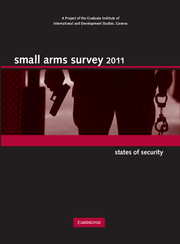Book contents
- Frontmatter
- Foreword
- Contents
- About the Small Arms Survey
- Notes to readers
- Acknowledgements
- Introduction
- Chapter 1 Larger but Less Known: Authorized Light Weapons Transfers
- Chapter 2 Fact or Fiction?: The UN Small Arms Process
- Chapter 3 Procurement and Policy: Police Use of Emerging Weapons Technology
- Chapter 4 A Booming Business: Private Security and Small Arms
- Chapter 5 Protected but Exposed: Multinationals and Private Security
- Chapter 6 Ethos of Exploitation: Insecurity and Predation in Madagascar
- Chapter 7 Reforming the Ranks: Public Security in a Divided Côte d'Ivoire
- Chapter 8 Securing the State: Haiti before and after the Earthquake
- Chapter 9 Balancing Act: Regulation of Civilian Firearm Possession
- Index
Chapter 9 - Balancing Act: Regulation of Civilian Firearm Possession
Published online by Cambridge University Press: 05 March 2012
- Frontmatter
- Foreword
- Contents
- About the Small Arms Survey
- Notes to readers
- Acknowledgements
- Introduction
- Chapter 1 Larger but Less Known: Authorized Light Weapons Transfers
- Chapter 2 Fact or Fiction?: The UN Small Arms Process
- Chapter 3 Procurement and Policy: Police Use of Emerging Weapons Technology
- Chapter 4 A Booming Business: Private Security and Small Arms
- Chapter 5 Protected but Exposed: Multinationals and Private Security
- Chapter 6 Ethos of Exploitation: Insecurity and Predation in Madagascar
- Chapter 7 Reforming the Ranks: Public Security in a Divided Côte d'Ivoire
- Chapter 8 Securing the State: Haiti before and after the Earthquake
- Chapter 9 Balancing Act: Regulation of Civilian Firearm Possession
- Index
Summary
INTRODUCTION
In all but a handful of countries around the world, civilians are permitted to purchase and possess firearms–with restrictions. While only a fraction of the world's civilians own guns, they possess a total of some 650 million–representing nearly three-quarters of the global firearm arsenal or approximately three times the number held by national armed forces and law enforcement (Small Arms Survey, 2007, p. 43; 2010, pp. 101–02). Permitted civilian uses of firearms typically include sport shooting, hunting, self-defence, and some types of professional work. Underpinning most national approaches to civilian firearm possession is an attempt to balance the prevention of social harm (crime, interpersonal violence, and suicide) with legitimate civilian use.
Although civilian firearm regulation has been debated in multilateral circles over the past two decades, it has largely eluded international control efforts. It is the prerogative of each country, based on its own mix of cultural, historical, and constitutional factors, to regulate civilian gun ownership as it sees fit. The resulting complexity and diversity of approaches make a comparative analysis of states' efforts to regulate civilian possession very difficult, and thus relatively few such studies have been undertaken.
This chapter seeks to fill this gap by analysing the legislation governing civilian access to and use of firearms in a sample of 42 jurisdictions (28 countries and 14 sub-national entities).
- Type
- Chapter
- Information
- Small Arms Survey 2011States of Security, pp. 261 - 309Publisher: Cambridge University PressPrint publication year: 2011



